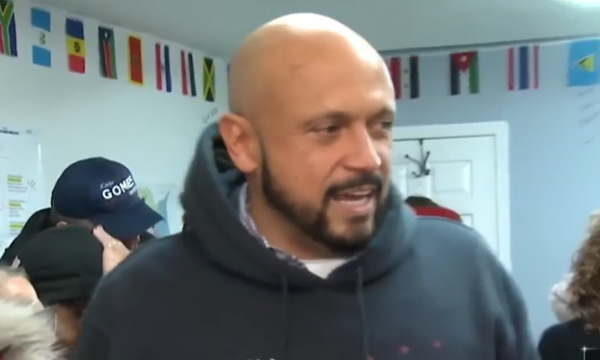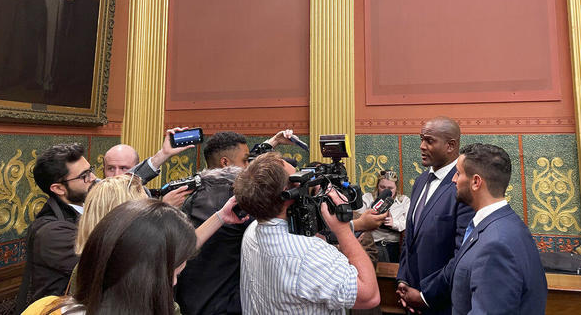Voters In More States Back Nonpartisan Redistricting
At least four states across the country voted last week to change how election maps will be drafted. Colorado and Michigan became the latest states to create nonpartisan redistricting commissions, and votes are still being counted to determine whether Utah will do the same.
Missouri changed the process by which existing bipartisan commissions draft new legislative districts, while Ohio adopted new rules for how a three-year-old commission will work with the legislature in drafting congressional districts.
Colorado
Colorado voters passed two constitutional amendments creating largely nonpartisan commissions to draft legislative and congressional districts.
Colorado legislative districts are now drafted by an 11-member Colorado Reapportionment Commission, but 6 members could be affiliated with the same political party. The legislature itself lays out congressional districts.
Under Amendments Y and Z, different commissions will decide new boundaries for state legislative and congressional districts. Each 12-member panel would consist of four representatives from each of the state’s two largest political parties (currently Democratic and Republican) and four more not affiliated with any party. The amendments require that the membership of each commission reflects Colorado’s racial, ethnic, gender, and geographic diversity and includes members from each congressional district, including at least one from the state’s so-called Western Slope.
Selection of commission members would be overseen by a panel of retired judges appointed by the Chief Justice of the Colorado Supreme Court, and each map must receive approval from at least 8 commissioners, including at least 2 unaffiliated members. Final maps would be reviewed by the Court to ensure that they were not drawn to dilute the electoral influence of any racial or ethnic group “or to protect any incumbent, any political candidate, or any political party.”
The proposed changes to the state constitution required at least 55% of votes to pass. Both received approximately 71%.
Michigan
Michigan voters almost did not get a chance to weigh in on the Independent Redistricting Commission Initiative. After a lengthy court battle, the Michigan Supreme Court narrowly ruled against an opposition group that sought to remove the question from the November ballot.
Proposal 2 sought to transfer power to draw the state’s legislative and congressional districts from the state legislature to a 13-member independent redistricting commission. Under this ballot initiative, 4 of the commissioners must be Republicans, four must be Democrats, and five must be independents or members of third parties.
The yes votes of at least seven members – including at least two Democrats, two Republicans, and two members not affiliated with the major parties – would be needed to pass any new redistricting plan. The commission would need to produce geographically continuous districts that are drawn fairly in compliance with federal laws. All commission meetings, drafts, data and conversations would be public records, and multiple public hearings would be required at various stages before a final vote. The commission’s finances would audited annually.
Proposal 2 passed with 61% of the vote.
Utah
Utah’s Proposition 4, another Independent Redistricting Commission Initiative, is currently tied at 50-50 in the election results, with 95% of precincts reporting. The Yes vote currently leads by a roughly 6,000-vote margin, but the outcome is still up in the air with a handful precincts yet to fully report.
If the Proposition does ultimately pass, it will create a seven-member independent redistricting commission to draft maps for congressional and state legislative districts. Of the seven, one member would be appointed by the governor, three by majority-party legislative leaders, and three by minority-party leaders. No person would be eligible to serve as a commissioner if, during the four years before appointment, he or she (1) was a lobbyist, (2) was a candidate for or holder of any political or elected office, or (3) was compensated by any political party, party committee, or political action committee associated with a such a party.
One a new map is approved by the commission, members would then submit redistricting plans to the Legislature for approval or rejection. Proposition 4 also sets standards for redistricting plans and authorizes lawsuits to block implementation of any plan enacted by the legislature that fails to conform to those standards.
Missouri
In Missouri, the state legislature now draws congressional districts, but state legislative districts are drafted by two bipartisan commissions, both selected by the political parties’ state committees. The “Clean Missouri” proposal, which passed with more than 60% of the vote, leaves congressional maps in the hands of the legislature, but amends the process for legislative districts only.
Amendment 1 calls for a new “non-partisan state demographer” to oversee the drafting of drafting new legislative maps. The state auditor would nominate at least three persons for this five-year appointment; the legislature could then either agree a candidate from this pool or opt for a process in which the pool of candidates is first winnowed down by each party before the new demographer is then picked at random from those that remain.
Under Amendment 1, all maps would need to meet a new standard of “partisan fairness,” meaning that “parties shall be able to translate their popular support into legislative representation with approximately equal efficiency.” Districts would also have to be “competitive,” meaning that “parties’ legislative representation shall be substantially and similarly responsive to shifts in the electorate’s preferences.”
The two existing commissions (one each for House and Senate districts) would still approve all maps, but must start by reviewing the demographer’s plans. In each case the demographer’s map would become final unless overturned by at least a 70% vote of the commission. .
Ohio
By nearly a 3:1 margin, Ohio voters approved Question 1, which changes the process by which an existing Ohio Redistricting Commission works with the legislature to create new congressional district maps.
The Ohio Redistricting Commission was established at the ballot box in 2015, years after the current congressional map was created. Question 1 creates a process under which the legislature first gets an opportunity to produce a bipartisan map – it must be supported by majorities of both the Republican and Democratic lawmakers, and must win at least 60% approval overall. If it fails, the Commission is given a chance to produce a map that must win endorsement by at least two of its minority-party members.
If neither is able to come up with a bipartisan map, the issue returns to the legislature, which can then approve one under less stringent requirements for minority-party support. Even so, if the final plan is not endorsed by at least one-third of the minority-party lawmakers, the resulting plan remains valid for only four years, not the usual ten.


